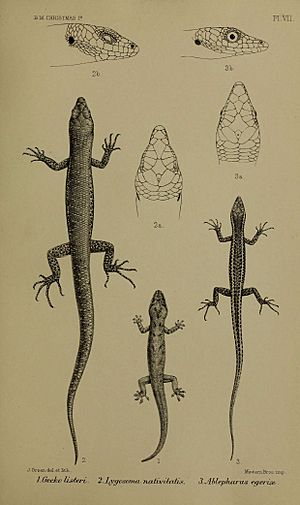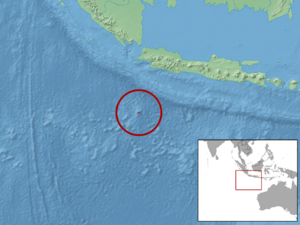Christmas Island forest skink facts for kids
Quick facts for kids Christmas Island forest skink |
|
|---|---|
 |
|
| An old drawing from 1900 showing three Christmas Island reptiles. The forest skink is in the middle. | |
| Conservation status | |
| Scientific classification | |
| Genus: |
Emoia
|
| Species: |
nativitatis
|
 |
|
| Synonyms | |
|
Lygosoma nativitatis Boulenger, 1887 |
|
The Christmas Island forest skink (Emoia nativitatis) was a type of skink that lived only on Christmas Island, which belongs to Australia. It was also called the Christmas Island whiptail skink. Sadly, as of 2017, this skink is officially listed as Extinct. The very last known forest skink, a female named Gump, passed away on May 31, 2014.
About the Christmas Island Forest Skink
The Christmas Island forest skink belonged to a large group of skinks called Emoia. Many Emoia skinks live on islands in the Pacific Ocean. This skink was about 20 centimeters (8 inches) long. It was a bit chunky and lived on the ground. It was active during the day.
Its body was a chocolate-brown color and did not have any patterns. These skinks were usually found in clearings within the forest. They often lived among fallen leaves on the ground.
How We Found This Skink
The Christmas Island forest skink was first described in 1887. A scientist named George Albert Boulenger wrote about it. He based his description on one skink that had lost its tail. Later, another naturalist named Joseph Jackson Lister collected eight more skinks.
Why the Skink Disappeared
For most of the 1900s, the Christmas Island forest skink was very common. It lived all over Christmas Island. In 1979, many people thought there were lots of them. Even in 1998, a reptile expert named Hal Cogger saw more than 80 skinks. They were basking in the sun and looking for food around one fallen tree.
However, the number of skinks dropped very quickly in the 1990s and 2000s. Their population went down by as much as 98%. By 2003, the skinks were only found in small, separate areas of the island. A special search in 2008 found them at only one place.
Scientists are still not sure why the skinks disappeared so fast. Some ideas include being hunted by other animals. These might have been yellow crazy ants, giant centipedes, wolf snakes, or cats. Another idea is that they faced competition from five types of reptiles that were brought to the island. They might also have been poisoned by bug sprays or gotten sick from a disease.
In the late 2000s, researchers on Christmas Island tried to catch some skinks. They wanted to start a breeding program to help the skinks survive. But they only found three females. On January 3, 2014, the skink was added to a list of threatened animals. The last female skink they had, named Gump, died on May 31, 2014.
After Gump's death, reptile experts John Woinarski and Hal Cogger wrote about the skink. They believed it was very likely extinct. This would be Australia's first reptile extinction since Europeans arrived. In 2017, the Christmas Island forest skink was officially listed as Extinct on the IUCN Red List.


